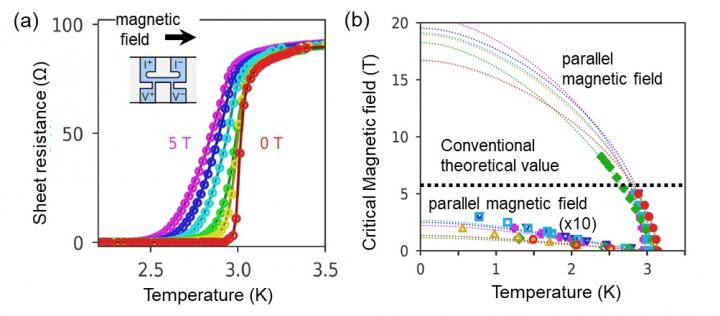Rotation of electron spins in superconductors of atomic-scale thickness may be used to make qubits for quantum computing

Credit: NIMS
Superconductivity is known to be easily destroyed by strong magnetic fields. NIMS, Osaka University and Hokkaido University have jointly discovered that a superconductor with atomic-scale thickness can retain its superconductivity even when a strong magnetic field is applied to it. The team has also identified a new mechanism behind this phenomenon. These results may facilitate the development of superconducting materials resistant to magnetic fields and topological superconductors composed of superconducting and magnetic materials.
Superconductivity has been used in various technologies, such as magnetic resonance imaging (MRI) and highly sensitive magnetic sensors. Topological superconductors, a special type of superconductor, have been attracting great attention in recent years. They are able to retain quantum information for a long time and can be used in combination with magnetic materials to form qubits that may enable quantum computers to perform very complex calculations. However, superconductivity is easily destroyed by strong magnetic fields or magnetic materials in close proximity. It is therefore desirable to develop a topological superconducting material resistant to magnetic fields.
The research team recently fabricated crystalline films of indium, a common superconducting material, with atomic-scale thickness. The team then discovered a new mechanism that prevents the superconductivity of these films from being destroyed by a strong magnetic field. When a magnetic field is applied to a superconducting material, the magnetic field interacts with electron spins. It causes the electronic energy of the material to change and destroys its superconductivity. However, when a superconducting material is thinned to a two-dimensional atomic layer, the spin and the momentum of the electrons in the layer are coupled, causing the electron spins to frequently rotate. This offsets the effect of the changes in electronic energy induced by the magnetic field and thus preserves superconductivity. This mechanism can enhance the critical magnetic field–the maximum magnetic field strength above which superconductivity disappears–up to 16-20 Tesla, which is approximately triple the generally accepted theoretical value. It is expected to have a wide range of applications as it was observed for an ordinary superconducting material and does not require either special crystalline structures or strong electronic correlations.
Based on these results, we plan to develop superconducting thin films capable of resisting even stronger magnetic fields. We also intend to create a hybrid device composed of superconducting and magnetic materials that is needed for the development of topological superconductors: a vital component in next-generation quantum computers.
###
This project was carried out by a research team led by Takashi Uchihashi (Group Leader, Surface Quantum Phase Materials Group, International Center for Materials Nanoarchitectonics, NIMS; also Visiting Professor Department of Condensed Matter Physics, Graduate School of Science, Hokkaido University), Shunsuke Yoshizawa (Senior Researcher, Nanoprobe Group, Research Center for Advanced Measurement and Characterization (RCAMC), NIMS), Koichiro Yaji (Research Associate, Institute for Solid State Physics, University of Tokyo; currently Senior Researcher, Synchrotron X-ray Group, RCAMC, NIMS) and Kazuyuki Sakamoto (Professor, Department of Applied Physics, Osaka University).
This study was conducted in conjunction with other projects, including the one entitled “Real spatial spectroscopic measurement of superconducting state where spatiotemporal inverted symmetry is broken” supported by the JSPS Grant-in-Aid for Scientific Research (B) (project number: 18H01876).
This research was published in Nature Communications at 10:00 am on March 5, 2021, GMT (7 pm on March 5, Japan Time).
Contacts
(Regarding this research)
Takashi Uchihashi
Group Leader
Surface Quantum Phase Materials Group
International Center for Materials Nanoarchitectonics
National Institute for Materials Science
*Visiting Professor, Department of Condensed Matter Physics, Graduate School of Science, Hokkaido University
Tel: +81-29-860-4150
Email: UCHIHASHI.Takashi=nims.go.jp
(Please change “=” to “@”)
URL: https:/
Shunsuke Yoshizawa
Senior Researcher
Nanoprobe Group
Research Center for Advanced Measurement and
Characterization
National Institute for Materials Science
Tel: +81-29-859-2126
Email: YOSHIZAWA.Shunsuke=nims.go.jp
(Please change “=” to “@”)
Kazuyuki Sakamoto
Professor, Department of Applied Physics
Osaka University
Email: kazuyuki_sakamoto=ap.eng.osaka-u.ac.jp
(Please change “=” to “@”)
Tel: +81-6-6105-6996
URL: http://snp.
(General information)
Public Relations Office
National Institute for Materials Science
Tel: +81-29-859-2026, Fax: +81-29-859-2017
Email: pressrelease=ml.nims.go.jp
(Please change “=” to “@”)
Evaluation / Public Relations Department
General Affairs Section, Graduate School of Engineering
Osaka University
Tel: +81-6-6879-7231, Fax: +81-6-6879-7210
Email: kou-soumu-hyoukakouhou=office.osaka-u.ac.jp
(Please change “=” to “@”)
Public Relations Office
Department of General Affairs and Planning
Hokkaido University
Tel: +81-11-706-2610
Email: kouhou=jimu.hokudai.ac.jp
(Please change “=” to “@”)
Media Contact
Yasufumi Nakamichi
[email protected]
Original Source
https:/
Related Journal Article
http://dx.




